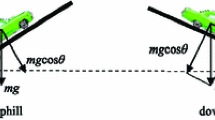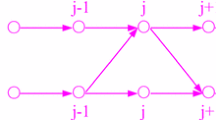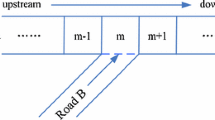Abstract
Sag sections are segments of the expressway where the slope changes greatly from downward to upward. In the expressway networks, sag sections are usually the bottleneck of traffic. Sag sections have become an important inducement of traffic congestion for its special geometric characteristics. However, the intrinsic mechanism of traffic congestion on sag sections is still unclear, especially the congestion in the tunnels. To describe the traffic flow of different road conditions, a dynamic optimal velocity function is proposed. Then, coupled with the proposed function, a new lattice hydrodynamic model is developed to reveal the influence of sag on the stability of traffic flow in the tunnel. The linear stability condition is further obtained to analyze the potential effects of sag on the dynamics of traffic flow. The modified Korteweg-de Vrie (mKdV) equation is also derived by using perturbation theory, and the corresponding kink-antikink soliton solution is obtained. Finally, the evolution process of traffic flow during the sag section is demonstrated by numerical simulation. It is suggested that the downhill section sag worse the stability of traffic flow, while the uphill section could stabilize the traffic flow, which is consistent with the theoretical analysis well. In addition, we also study the evolution laws of density waves under different disturbances in the metastable region.










Similar content being viewed by others
References
T.Q. Tang, H.J. Huang, S.G. Zhao, G. Xu, Int. J. Mod. Phys. B. 23, 743 (2009). https://doi.org/10.1142/S0217979209051966
L.J. Zheng, C. Tian, D.H. Sun, W.N. Liu, Nonlin. Dyn. 70, 1205 (2012). https://doi.org/10.1007/s11071-012-0524-x
G.H. Peng, R.J. Cheng, Physica A. 392, 3563 (2013). https://doi.org/10.1016/j.physa.2013.04.011
X.P. Li, J.X. Cui, S. An, M. Parsafard, Transport. Res. B. 70, 319 (2014). https://doi.org/10.1016/j.trb.2014.09.014
R. Jiang, M.B. Hu, H.M. Zhang, Z.Y. Gao, B. Jia, Q.S. Wu, Transport. Res. B. 80, 338 (2015). https://doi.org/10.1016/j.trb.2015.08.003
S.W. Yu, Z.K. Shi, Measurement 64, 34 (2015). https://doi.org/10.1016/j.measurement.2014.12.036
G.H. Peng, W.Z. Lu, H.D. He, Z.H. Gu, Commun. Nonlin. Sci. 40, 197 (2016). https://doi.org/10.1016/j.cnsns.2016.04.024
R.J. Cheng, H.X. Ge, J.F. Wang, Phys. Lett. A. 381, 2792 (2017). https://doi.org/10.1016/j.physleta.2017.06.047
T.Q. Tang, Z.Y. Yi, J. Zhang, T. Wang, J.Q. Leng, Physica A. 496, 399 (2018). https://doi.org/10.1016/j.physa.2018.01.005
Q.T. Zhai, H.X. Ge, R.J. Cheng, Physica A. 490, 774 (2018). https://doi.org/10.1016/j.physa.2017.08.152
J.F. Tian, G.Y. Li, M. Treiber, R. Jiang, N. Jia, S. Ma, Transport. Res. B. 93, 560 (2016). https://doi.org/10.1016/j.trb.2016.08.008
J.F. Tian, B. Jia, S. Ma, C. Zhu, R. Jiang, Y. Ding, Transportation Sci. 51, 807 (2016). https://doi.org/10.48550/arXiv.1503.05986
D. Helbing, M. Treiber, Phys. Rev. Lett. 81, 3042 (1998). https://doi.org/10.1103/PhysRevLett.81.3042
G.H. Peng, W. Song, Y.J. Peng, S.H. Wang, Physica A. 398, 76 (2014). https://doi.org/10.1016/j.physa.2013.12.015
R.J. Cheng, H.X. Ge, J.F. Wang, Physica A. 481, 52 (2017). https://doi.org/10.1016/j.physa.2017.04.004
R.J. Cheng, H.X. Ge, J.F. Wang, Phys. Lett. A. 381, 1302 (2017). https://doi.org/10.1016/j.physleta.2017.02.018
T.Q. Tang, H.J. Huang, H.Y. Shang, Physica A. 468, 322 (2016). https://doi.org/10.1016/j.physa.2016.10.092
R.J. Cheng, H.X. Ge, J.F. Wang, Phys. Lett. A. 381, 2608 (2017). https://doi.org/10.1016/j.physleta.2017.06.008
Y. Xue, Y. Guo, Y. Shi, L.Z. Lv, H.D. He, Nonlin. Dyn. 88, 145 (2017). https://doi.org/10.1016/j.physleta.2017.06.008
R.J. Cheng, H.X. Ge, J.F. Wang, Appl. Math. Comput. 332, 493 (2018). https://doi.org/10.1016/j.amc.2018.03.077
G.H. Peng, S.H. Yang, H.Z. Zhao, Phys. Lett. A. 382, 2595 (2018). https://doi.org/10.1016/j.physleta.2018.06.039
T. Nagatani, Physica A. 261, 599 (1998). https://doi.org/10.1016/S0378-4371(98)00347-1
T. Nagatani, Physica A. 264, 581 (1999). https://doi.org/10.1016/S0378-4371(98)00466-X
G. Zhang, D.H. Sun, H. Liu, D. Chen, Physica A. 486, 806 (2017). https://doi.org/10.1016/j.physa.2017.05.050
G.H. Peng, X.Q. Li, K.L. Fang, Physica A. 486, 814 (2018). https://doi.org/10.1016/j.physa.2017.05.061
D.H. Sun, G. Zhang, M. Zhao, S.L. Cheng, J.D. Cao, Commun. Nonlin. Sci. 56, 287 (2018). https://doi.org/10.1016/j.cnsns.2017.08.004
T. Wang, R.D. Zang, K.Y. Xu, J. Zhang, Physica A. 526, 120711 (2019). https://doi.org/10.1016/j.physa.2019.03.076
J. Zhang, K.Y. Xu, S.B. Li, T. Wang, Physica A. 551, 124249 (2020). https://doi.org/10.1016/j.physa.2020.124249
A.K. Gupta, P. Redhu, Physica A. 392, 5622 (2013). https://doi.org/10.1016/j.physa.2013.07.040
A.K. Gupta, P. Redhu, Nonli. Dyn. 76, 1001 (2014). https://doi.org/10.1007/s11071-013-1183-2
G.H. Peng, S.H. Yang, H.Z. Zhao, L. Qing, Int. J. Mod. Phys. C. 29, 1850083 (2018). https://doi.org/10.1142/S012918311850083
Y.Y. Chang, Z.T. He, R.J. Chen, Physica A. 514, 522 (2019). https://doi.org/10.1016/j.physa.2018.09.097
Q.Y. Wang, R.J. Cheng, H.X. Ge, Physica A. 559, 125023 (2020). https://doi.org/10.1016/j.physa.2020.125023
H.X. Ge, R.J. Cheng, Physica A. 387, 6952 (2008). https://doi.org/10.1016/j.physa.2008.05.060
P. Redhu, A.K. Gupta, Commun. Nonlin. Sci. 27, 263 (2015). https://doi.org/10.1016/j.cnsns.2015.03.015
P. Redhu, A.K. Gupta, Physica A. 445, 150 (2016). https://doi.org/10.1016/j.physa.2015.10.051
K. Komada, S. Masukura, T. Nagatani, Physica A. 388, 2880 (2009). https://doi.org/10.1016/j.physa.2009.03.029
H.X. Ge, R.J. Cheng, S.M. Lo, Commun. Theor. Phys. 62, 259 (2014). https://doi.org/10.1088/0253-6102/62/2/13
A.K. Gupta, S. Sharma, P. Redhu, Commun. Theor. Phys. 62, 393 (2014). https://doi.org/10.1088/0253-6102/62/3/17
J.L. Cao, Z.K. Shi, Commun. Nonlin. Sci. 33, 1 (2016). https://doi.org/10.1016/j.cnsns.2015.08.025
R. Kaur, S. Sharma, Physica A. 471, 59 (2017). https://doi.org/10.1016/j.physa.2016.11.116
R. Kaur, S. Sharma, Physica A. 499, 110 (2018). https://doi.org/10.1016/j.physa.2017.12.101
H.X. Ge, R.J. Cheng, Q.Y. Wang, Phys. Lett. A. 383, 1879 (2019). https://doi.org/10.1016/j.physleta.2019.03.019
Acknowledgements
This work was supported by the National Natural Science Foundation of China (Grant No. 71971125, 72222021) and The Natural Science Foundation of Shandong Province (Grant No. ZR2021MG026).
Author information
Authors and Affiliations
Corresponding author
Additional information
Publisher's Note
Springer Nature remains neutral with regard to jurisdictional claims in published maps and institutional affiliations.
Rights and permissions
Springer Nature or its licensor holds exclusive rights to this article under a publishing agreement with the author(s) or other rightsholder(s); author self-archiving of the accepted manuscript version of this article is solely governed by the terms of such publishing agreement and applicable law.
About this article
Cite this article
Yuan, J., Wang, T., Cui, F. et al. Mechanism analysis of traffic congestion at sag section of the tunnel. J. Korean Phys. Soc. 81, 796–808 (2022). https://doi.org/10.1007/s40042-022-00599-4
Received:
Revised:
Accepted:
Published:
Issue Date:
DOI: https://doi.org/10.1007/s40042-022-00599-4




